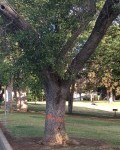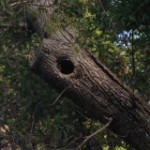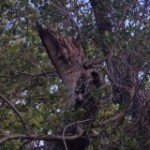Subscribe to our Newsletter!
 East Sacramento Preservation
East Sacramento Preservation- Neighborhood National Night Out Celebration 07/25/2023
- East Sacramento Preservation 2023 Scholarship Winners 07/20/2023
- Neighborhood National Night Out Celebration 07/30/2022
- East Sacramento Preservation 2022 Scholarship Winners 07/26/2022
- Tell the City: Climate Action Plan must Protect Trees 07/24/2022
Category Archives: Trees
Let’s Keep the Bluebird of Happiness
Cavity-nesting birds in East Portal Park
The drought has killed several trees in East Portal Park and I now see that many of them have been marked with an orange ring, presumably so that they can be taken down. While I recognize the need to remove any which pose a safety risk, it is also important for the city to consider the wildlife value of these very trees.
Our city is home to a wide variety of bird species, many of which breed right in town. Among those birds, some nest only in cavities in trees. For the most part the trees, which provide the best cavities for these birds, are ones which are dead or dying. I walk East Portal Park nearly every morning and have noted that at least three bird species have nested each year in cavities in trees in this park: Nuttall’s Woodpecker (a woodpecker found only along the west coast in California and Oregon), Western Bluebird, and Oak Titmouse. In particular, all three species are using cavities in some of the marked trees. (Zelkova species, I believe.) I am hopeful that the city will consider saving at least one or two of these trees.
I also understand that, besides safety issues, there is an aesthetic reason for taking down dead or dying trees. Few people actually understand that, from a wildlife perspective, these are often the most valuable trees in a forests (urban OR native forests). Many other communities have recognized this and have implemented programs to try to save some of these trees, marking them with “Wildlife Tree” signage so that the public understands why they have been saved. One example is a program in place in Orange County (http://cavityconservation.com/). An example of the type of signage used is shown below.
I have included a few photos showing cavities which have been used by nesting birds in recent years in East Portal Park. One tree in particular has been very productive and I am hopeful that this tree, at least, can be retained. It is along M Street, just where 51st intersects.
Contributed by Ed Pandolfino, Ph.D. (former president of Western Field Ornithologists, co-author of Birds of the Sierra Nevada)
Posted in East Portal, Ed Pandolfino, Essays, Parks, Preservation District, Trees, Uncategorized
Tagged bluebirds, drought, East Portal, East Sacramento, East Sacramento Neighborhood Associations, East Sacramento Preservation, nut, trees, Urban Wildlife, woodpecker
Comments Off on Let’s Keep the Bluebird of Happiness
Insist on Trees
 Our mother insisted on trees. She made a little village under the Christmas tree every year, and the village had to be crowded with tiny trees. She was from the Midwest and said, “Believe me, you don’t want to live without trees.” This gave me the notion that the Midwest was a vast and barren Arabia-like wasteland where people moved listlessly, blinded by a burning glob of unfiltered sun. My little brother Michael liked to watch the Christmas village go up, and one year he was allowed to help put in the trees. Every little house had at least two trees, and taller trees were placed behind them, to suggest the nearness of a great forest. My mother said Michael was the best tree placer she had ever seen, and had made the village come alive. The trees, she said, turned plain little houses into snug beautiful homes.
Our mother insisted on trees. She made a little village under the Christmas tree every year, and the village had to be crowded with tiny trees. She was from the Midwest and said, “Believe me, you don’t want to live without trees.” This gave me the notion that the Midwest was a vast and barren Arabia-like wasteland where people moved listlessly, blinded by a burning glob of unfiltered sun. My little brother Michael liked to watch the Christmas village go up, and one year he was allowed to help put in the trees. Every little house had at least two trees, and taller trees were placed behind them, to suggest the nearness of a great forest. My mother said Michael was the best tree placer she had ever seen, and had made the village come alive. The trees, she said, turned plain little houses into snug beautiful homes.
 When we went on vacations we would clamber into the station wagon and head to the Calaveras Big Trees or to our aunt and uncle’s cabin in the mountains. When we got there we ran around screaming, hiding, climbing, and having multiple false sightings of bears. We brought our high-pitched childish intoxication to the quiet, tall forest, but in time its grandeur subdued us, and we walked the little trails, waded in the thrilling chill of the river, breathed in the air of pine and fir. When we went home our parents eased our re-entry crisis by letting us camp in the back yard. We looked at the moon through the leaves of the apricot tree and told scary stories. By midnight we were back in the house, having terrified ourselves into seeing ghouls with glittering eyes crouching in the Toniola’s vegetable garden next door.
When we went on vacations we would clamber into the station wagon and head to the Calaveras Big Trees or to our aunt and uncle’s cabin in the mountains. When we got there we ran around screaming, hiding, climbing, and having multiple false sightings of bears. We brought our high-pitched childish intoxication to the quiet, tall forest, but in time its grandeur subdued us, and we walked the little trails, waded in the thrilling chill of the river, breathed in the air of pine and fir. When we went home our parents eased our re-entry crisis by letting us camp in the back yard. We looked at the moon through the leaves of the apricot tree and told scary stories. By midnight we were back in the house, having terrified ourselves into seeing ghouls with glittering eyes crouching in the Toniola’s vegetable garden next door.
We knew to value trees. They shaded us, they brought natural beauty to the humblest street, they resided with stately permanence over our hectic comings and goings. We were never to put a nail in one, strip its bark, or let it go thirsty. I didn’t know then that trees filtered the very air for us, but I know it now.
It’s a commonplace but valid observation that you often don’t realize how much you love something until you lose it. We moved away from old, historic East Sac and into the burbs when I was twelve. Our new development had roomy houses and nice neighbors, but no trees. Lawns were being put in and there were numerous sticks with a frail leaf or two attached. Baby trees, my mother said. I asked how long it would take them to grow. Thirty years? I did a bleak calculation. I would be forty-two when the trees turned the stretch of bare houses into an East Sacramento-like street of shaded homes. “I’ll be nearly dead,” I said mournfully. This provoked considerable merriment from my parents who, I thought, were getting too much enjoyment from my sufferings.
The first treeless summer was hard. There was nowhere to hide from the sun. By now I had entered full and histrionic adolescence and become hypersensitive to everything, including the air itself which I claimed stunk like charred fish. I was somewhat right on this one: dust, continued excavation, exhaust, and the treeless void combined to make our suburban air putrid with toxins. It was the start of a life-long battle with asthma. This is one reason I presently feel sorry for people who might live in the McKinley Village basin: they’re going to inhale a bombardment of poisons from auto and train emissions, and the sad stick trees won’t help them.
I moved back to East Sac in my forties, (not so decrepit as I imagined at thirteen) back to the world of large, sheltering, old growth trees. There’s a reason our area is so desirable, and those trees enveloping well-made craftsman and modern architecture houses are it. Yes, super-sized Mac-mansions, overbuilt to a grotesque degree, threaten us, but we have ways to resist. I think we should use them. I think if our shaded streets are preserved, our people will always want to come home. For this reason many East Sacramentans unstintingly support the coalition of citizens who fight to preserve the tree canopy at Capitol Towers. These people know what brings enduring value to this city. I will be proud to join them.
Pat Lynch
Posted in McKinley Park, Trees, Uncategorized
Tagged capitol towers, city of sacramento, East Sacramento Neighborhood Associations, East Sacramento Preservation, heritage, preservation, Sacarmento, tree, trees
Comments Off on Insist on Trees





















 Subscribe In A Reader.
Subscribe In A Reader. Check Us Out On Facebook!
Check Us Out On Facebook! Check Us Out On Twitter!
Check Us Out On Twitter! Visit Nextdoor!
Visit Nextdoor!








